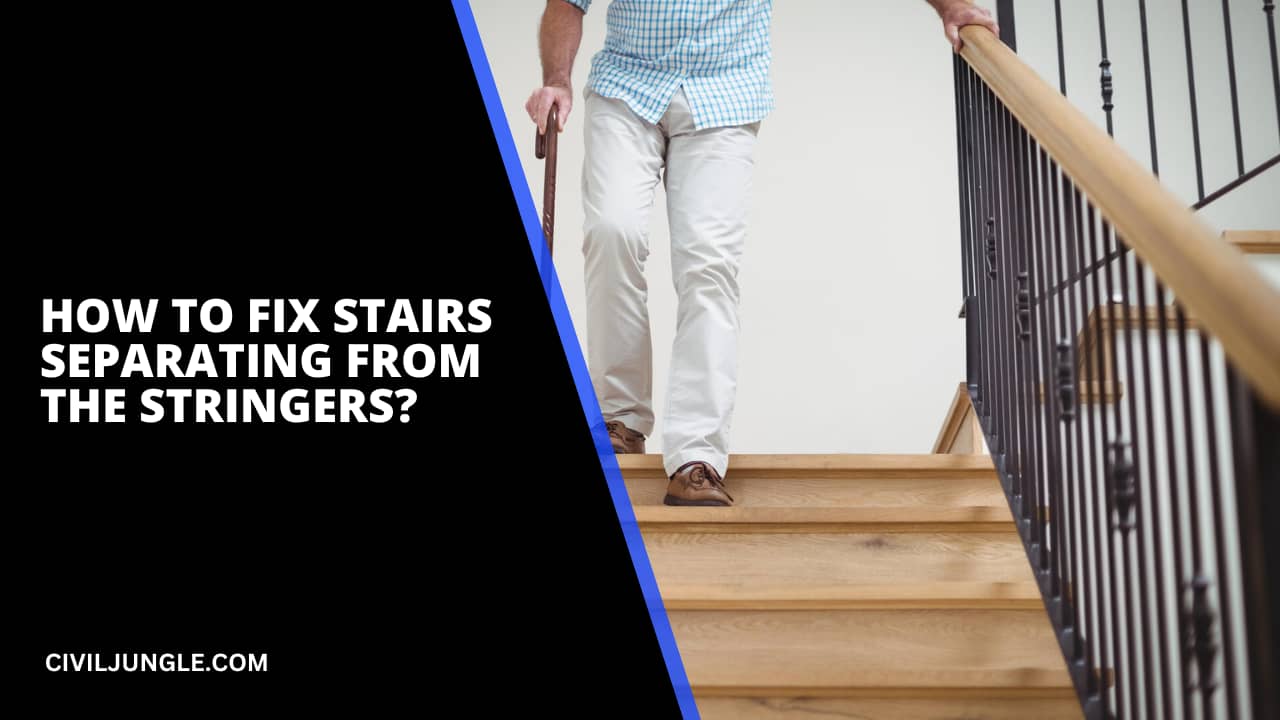When the supportive structure of your staircase begins to falter, it not only undermines the safety of your home but also compromises its aesthetic appeal. Separating stairs can pose a serious hazard to you and your loved ones, especially if left unattended. Fortunately, with the right tools and techniques, it’s possible to restore your staircase to its former glory.

Image: civiljungle.com
Understanding Stair Separation and Its Causes
Stair separation occurs when the treads and risers of a staircase begin to detach from the support structure, causing gaps and uneven surfaces. There can be several underlying causes for this problem, including:
Structural Damage: Over time, stairs can suffer from structural issues such as weakened joists, loose bolts, or rotting support beams. These can result from both age-related wear and tear or external factors like excessive weight or water damage.
Material Shrinkage: Wooden stairs are susceptible to shrinkage as they age, especially if the wood used wasn’t properly dried or sealed. This can lead to gaps forming between treads and risers, as well as other structural problems.
Subflooring Deterioration: The subflooring beneath your staircase provides the foundation for the stairs themselves. If the subflooring becomes damaged or decayed, it can cause the stairs to shift and separate.
Loose Fasteners: The bolts, screws, and nails that hold stairs together can loosen over time, leading to stair separation. Loose fasteners can also be caused by excessive movement or heavy use of the stairs.
Step-by-Step Guide to Repairing Separating Stairs
Before you begin any repairs, it’s crucial to ensure your own safety. Secure the staircase by placing wedges or supports beneath the separated treads to prevent further movement. You’ll also need the following tools:
Safety Gear: Safety glasses, gloves, and a dust mask
Tools: Hammer, screwdriver, pry bar, circular saw, wood filler, wood glue
Materials: Nails, screws, shims, plywood or wood blocks
1. Assess the Damage: Determine the extent of the separation and identify the underlying cause. Visually inspect the treads, risers, support beams, and subflooring for signs of damage or deterioration.
2. Secure the Loose Treads: If the treads have separated from the risers, use a pry bar to gently lift them back into place. Secure them with screws or nails driven into the treads and risers. Ensure the screws are long enough to penetrate through both pieces of wood.
3. Replace Damaged Risers: If a riser is broken or severely damaged, it needs to be replaced. Measure the old riser and cut a new one from plywood or solid wood. Install the new riser by attaching it to the treads and support beams using screws or nails.
4. Reinforce the Support Structure: If the support beams or joists supporting the stairs are weakened or damaged, they need to be reinforced. This may involve adding additional support blocks, strengthening the existing structure with bolts or plates, or replacing the damaged beams entirely.
5. Repair Subflooring Damage: If the subflooring beneath the staircase is damaged or decayed, you may need to replace the affected section. Cut out the damaged subflooring using a circular saw and install a new piece of plywood. Secure the new subflooring with nails or screws.
6. Fill Gaps and Seal Joints: Gaps between treads, risers, or support structures can be filled with wood filler. Apply the wood filler generously and use a putty knife to smooth it out. Once the wood filler dries, sand the area smooth and seal the joint with wood glue.
7. Reset the Staircase: Once the repairs are complete, reset the entire staircase by using a hammer to tap down the treads and risers firmly. This ensures the staircase is level and secure.
/Wooden-Stairs-510587539-576eab965f9b58587566bb4e.jpg)
Image: www.thespruce.com
How To Fix Stairs That Are Separating
Preventive Measures for Long-Lasting Stairs
To maintain the integrity of your staircase and prevent future separation, follow these preventive measures:
Proper Maintenance: Inspect your stairs regularly for signs of damage or wear. Tighten loose bolts or screws promptly and repair any minor cracks or gaps to prevent them from becoming major problems.
Weight Distribution: Avoid placing excessive weight on the stairs, especially in one concentrated area. Distribute heavy items evenly and refrain from overloading the staircase.
Humidity Control: Fluctuating humidity levels can affect wooden stairs, causing shrinkage and warping. Maintain consistent humidity levels in your home using a humidifier or dehumidifier as needed.
Waterproof Sealant: Consider treating the stairs with a waterproof sealant to protect them from moisture damage and extend their lifespan. Reapply the sealant every few years to maintain its effectiveness.
By following these tips, you can ensure your staircase remains a solid and safe passageway for many years to come. If you’re not confident performing the repairs yourself, it’s always advisable to consult with a qualified professional such as a carpenter or a general contractor. They can evaluate the situation, determine the most appropriate repair method, and ensure the work is done safely and effectively.







